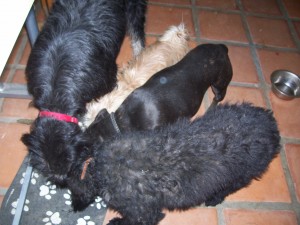Archives for Housebreaking category
Posted on Nov 08, 2013
Dog Training, House Training, Housebreaking, Palm Springs Dog Trainer, Puppies, Yorkie
These little guys are just too cute. At almost four months old, these Yorkie brothers are learning their names and quickly becoming aware of their surroundings and their new home where they will be loved endlessly. They will require constant supervision (crate, x-pen, or on a leash) and a consistent schedule for feeding and house-training. We will begin basic obedience where “good” and “yes” are heard far more than “no”. Right boys? “YES!”

Posted on Apr 01, 2010
Behavioral Modification, Dog Humor, House Training, Housebreaking, Palm Springs Dog Training, Uncategorized

If this doesn’t work for you, get a copy of my ebook “The Truth About Housebreaking.” Maybe if your dog sees you reading the book, he will be more than willing to take this vow.
Posted on May 16, 2009
Discussion Tab, Dog Food, Dog Psychology, Housebreaking, Socialization
It’s not news that dark chocolate can be toxic to your dog. What to do? If they have ingested the chocolate within an hour or two, you can induce vomiting by giving them hydrogen peroxide. It varies by the size of the dog; however, it doesn’t take much. For small dogs, give them a Tablespoon and follow with another Tablespoon until you get the desired result.
Recently, a Great Dane ate a lot of dark chocolate. It could have been hours since she ate it, so they chose to wait and monitor her behavior. This Dane inherently exhibits some of the behaviors you should watch for when a dog consumes too much chocolate – she’s already restless, exciteable, and at times pants excessively. The point. . .it is to be taken seriously, but don’t panic and attribute their normal behavior to being a reaction to chocolate.
Since it was too late to induce vomiting, the Dane didn’t go to the vet and was monitored at home. Fortunately, she was able to “pass” the chocolate and process the caffeine and theobromine (stimulants) that were absorbed into her system.
I don’t doubt there have been a lot of sick dogs due to chocolate prior to our knowing it’s potential harm; however, I have heard so many dog owners say quietly that they used to give their dogs oreo cookies as treats. Some were even given chocolate kisses! My guess is they weren’t given enough to do harm and we weren’t nervously looking for symptoms.
Information is knowledge and may save you a trip to the vet. My best advice is to eat the dark chocolate and give the dog a dry, nearly tasteless dog biscuit. No wonder they too love chocolate!
Go to this article for more detailed information on Why Dogs Can’t Eat Chocolate
Posted on Mar 19, 2009
Adopt a Shelter Dog, Agility, Behavioral Modification, Dog Training, Doggie Rehab, Housebreaking, Rehoming a Dog, Training
Along the lines of giving a dog a job to do, agility training uses their focus and energy in a very fun way! It’s not about them being corrected for something they did wrong. It’s about being rewarded and praised constantly for getting it right!
And, “right” in this case is fun (usually for everyone). It’s easy for the handler (owner usually) to get too serious and set the bar (no pun intended) too high. The dogs are dogs and they’re not very good at being robots. If they were, we could leave fun out of the equation.
If you feel like the only time you spend with your dog is in training or in telling them “no,” try adding some fun by setting up jumps or other agility-type equipment in your home. Lay a broom handle across a stack of books and have your dog jump over it. Get a kid’s play tunnel and teach your dog to run through it. You’ll be on the other side! Be creative. For a change of pace, think of ways to use their energy and focus that isn’t quite so structured.
I recently participated in an agility event at a local senior center. It was a lot of fun for the dogs and the seniors!


Posted on Jan 22, 2009
Behavioral Modification, Dog Training, Housebreaking
Pee pads are used a lot by breeders and provide a method of quick cleanup for puppy messes. They are extremely useful in the right circumstances. Many choose to use them when a puppy first comes home.
If, however, you want to get away from the pads and want the dog to soil outside, don’t use them as a means of convenience. You will be teaching your dog that soiling in the house is acceptable. Typically, a dog does not like to eliminate where they sleep and eat. If you are unknowingly encouraging that, housebreaking will be very challenging.
 More than one dog trained using pads, continues to mistake a throw rug for a pad if it needs to go out and can’t immediately get there.
More than one dog trained using pads, continues to mistake a throw rug for a pad if it needs to go out and can’t immediately get there.
In the cases I’m referring to, the dog is housebroken and has developed his ability to hold it. They have to go and don’t see an obvious way to get outside. “Oh look, there’s a throw rug that looks vaguely like a pee pad, so I’ll just go right there.”
Due to restrictions, travel, or limited access to a safe place for the dog, some people choose to use pee pads exclusively. Housebreaking (potty training) would follow the same guidelines as if you are taking the dog outside; but rather than taking the dog outside, you will take the dog to the pad. Supervision is still required and praise for using the pad. If at all possible, place the pad in a separate area from their bed so they have to “go to the bathroom” in the desired area with the pad.
For a complete guide to Housebreaking, order my ebook with step-by-step instruction which comes with a second book on crate training.
Posted on Jan 10, 2009
Behavioral Modification, Crate Training, Dog Psychology, Dog Training, Housebreaking
You would think that if a dog is “housebroken” and potties outside most of the time, there is no concern right?
If you use a dog door to teach your dog to go potty outside, there is no guarantee that when the door is closed to the outside it won’t opt to go inside if given the chance. They don’t truly know not to go inside when the access to the outside is removed.
Dog doors are great! They serve a wonderful purpose and allow us the freedom to leave our dogs for longer period of time. However, it is best to completely housebreak your dog prior to introducing them to the dog door. Or, use the dog door in the process of housebreaking but still go outside with them to assure they are going and not just outside for a breath of fresh air!
We’ve all experienced the “what are you thinking” moment when our dog has been outside unattended for two hours (so, of course they went potty – right?!) only to have them come inside and go. Remember a puppy can be distracted by a leaf blowing and completely forget whey they are outside!
For detailed instruction on housebreaking, check out my ebook “The Truth About Housebreaking” or send me a question using the box to the right. I’m glad to assist in any way I can.
Posted on Dec 28, 2008
Behavioral Modification, Discussion Tab, Dog Psychology, Housebreaking
This is a legitimate question. It’s the one we whisper to someone because it is a little embarrassing to admit that our dog finds it’s poop to be a delicacy. There are ways to deter this behavior. Not to worry – here’s a page taken from my “The Truth About Housebreaking” ebook.
In this, I make light of the problem, but I do understand that it can be very frustrating. Ruling out other issues, the best thing you can do is monitor your dog, don’t give them the opportunity to eat poop, and they will mostly grow out of this behavior.
Why Dogs Eat Poop
Posted on Oct 22, 2008
Behavioral Modification, Dog Psychology, Dog Training, Housebreaking
It’s never too early to begin “training” your dog. I know how tough it is to bring home a puppy and not fill their every moment with your attention and affection. You may be setting yourself up for more than you can or want to handle later. I am referring to the time prior to them being able to focus on specific training.
Obedience training starts when your dog is about four months old, but don’t wait to begin. If the pup is mature enough and/or if they are a large breed dog – start earlier. They won’t be able to focus for more than about 10-15 minutes at a time, so it’s not about duration. It’s about establishing the pattern of behavior that you want for your life with this puppy as it becomes a “dog.”
Puppies are puppies. Brilliant, I know! If you are waiting for them to outgrow puppy to start training them, you will certainly have your patients tried. It can be done, but why wait?
Establishing your authority and the dog’s place with it’s new family begins the minute they come home with you. This is when housebreaking starts and when the puppy gets socialized and made aware of what life is like living with humans. We can be challenging!
Remember, they know how to be dogs and they will do it extremely well. Don’t wait “until” – start immediately providing a safe place where mutual trust and respect nourishes a relationship that will last a lifetime. They’ll love you for it!

Posted on Oct 18, 2008
Behavioral Modification, Crate Training, Dog Training, Housebreaking
Crate training can be a necessity for housebreaking. It also provides a place of safety for your dog and that may mean sanity for you. I often get calls about a “destructive” behavior that a well-behaved dog has suddenly been expressing.
It’s never too late to crate train. The biggest question is what behavior is making you ask this question in the first place? If you are wanting to housebreak a puppy or an older dog, crate training is a great option. You will have to use time and patience in both cases to acclimate them to the idea of being confined.
If you have a dog that is being destructive and housebreaking is not an issue, then you may want to use a play pen or something larger than what is used for housebreaking. This will provide a secure place for your dog and give them room to move around.
There are a lot of variables to crate training. If you are interested in learning more, I have written a Guide that explains the crate training process and how to housebreak any dog .
Posted on Aug 27, 2008
Dog Food, Dog Psychology, Housebreaking
As I cleaned out the kitty litter box this morning, I thought of how cat poop is such a wonderful delicacy to most dogs. They would never pass on a serving of “kitty rocca!” Makes me wonder. Maybe I could start a recycling program. I’ll save that for another blog post! For now, I’ll write more about dog food.
This is a common concern among dog people. So many questions. What if I’m not feeding my dog the “right” food? What if they suddenly act as if they don’t like their food?
If they become ill we can wonder and speculate that we contributed to this by not choosing a different dog food. I am not going to minimize that, but I do like to be the or at least a voice of reason. If your dog is eating the food, their coat looks good, they are healthy and active – be grateful and stop questioning.
If your dog has suddenly decided to skip a meal, that doesn’t mean the food is bad or that they are deciding to be picky, they may have other issues. Maybe it’s just too hot to care about food or they ate something in the yard yesterday and they need to let things settle before a meal.
There are things you can add to their food to make it more tasty, but wait on that and see if they don’t return to their food. If they have other symptoms along with not eating, then there might be reason for greater concern. Maybe some won’t relate to this; but, most of us don’t worry and stress if we skip a meal because we just don’t feel like eating.
Remember, as your dog quickly swallows that morsel of “kitty rocca” – they can’t be that picky!














